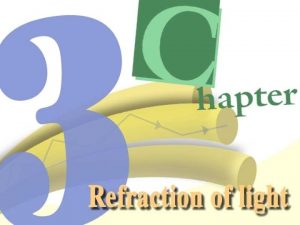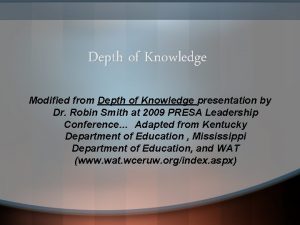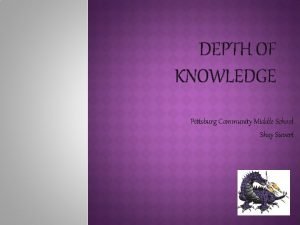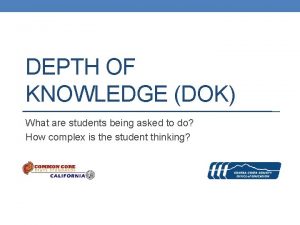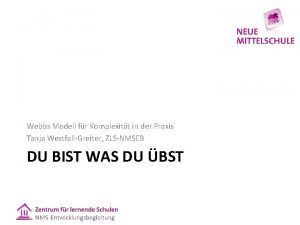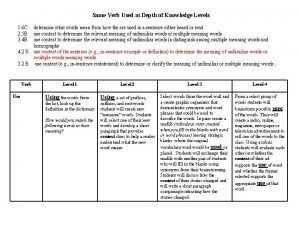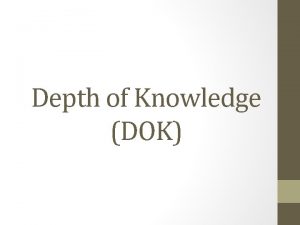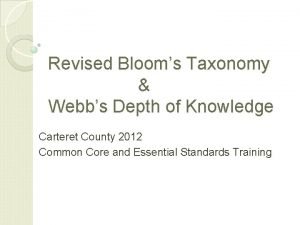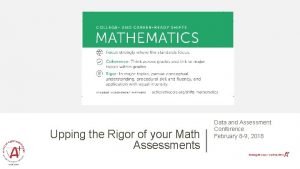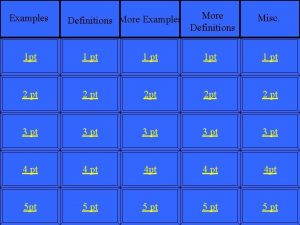Depth of Knowledge Definitions Examples Depth of Knowledge










- Slides: 10

Depth of Knowledge Definitions & Examples

Depth of Knowledge • Level 1 (Recall) – facts, figures, terms, simple procedures, etc. • Level 2 (Skill/Concept) – engagement of some mental processing beyond an habitual response. • Level 3 (Strategic Thinking) – requires reasoning, planning, using evidence, and a higher level of thinking than the previous two levels. • Level 4 (Extended Thinking) – requires complex reasoning, planning, developing, and thinking, most likely over an extended period of time.

Recall and Reproduction: DOK Level 1 • Requires recall of information, such as a fact, definition, term, or performance of a simple process or procedure • Answering a Level 1 item can involve following a simple, well-known procedure or formula

Recall and Reproduction: DOK 1 Examples • List animals that survive by eating other animals • Locate or recall facts found in text • Describe physical features of places • Determine the perimeter or area of rectangles given a drawing or labels • Identify elements of music using music terminology • Identify basic rules for participating in simple games and activities

Skills/Concepts: DOK Level 2 • Includes the engagement of some mental processing beyond recalling or reproducing a response • Items require students to make some decisions as to how to approach the question or problem • Actions imply more than one mental or cognitive process/step

Skills/Concepts: DOK 2 Examples • Compare desert and tropical environments • Identify and summarize the major events, problems, solutions, conflicts in literary text • Explain the cause-effect of historical events • Predict a logical outcome based on information in a reading selection • Explain how good work habits are important at home, school, and on the job • Classify plane and three dimensional figures • Describe various styles of music

Strategic Thinking: DOK Level 3 • Requires deep understanding exhibited through planning, using evidence, and more demanding cognitive reasoning • The cognitive demands are complex and abstract • An assessment item that has more than one possible answer and requires students to justify the response would most likely be a Level 3

Strategic Thinking: DOK 3 Examples Develop a scientific model for a complex idea • Propose and evaluate solutions for an economic problem • Explain, generalize or connect ideas, using supporting evidence from a text or source • Create a dance that represents the characteristics of a culture •

Extended Thinking: DOK Level 4 • Requires high cognitive demand is very complex • Students are expected to make connections, relate ideas within the content or among content areas, and select or devise one approach among many alternatives on how the situation can be solved • Due to the complexity of cognitive demand, DOK 4 often requires an extended period of time

Extended Thinking: DOK 4 Examples • Gather, analyze, organize, and interpret information from multiple (print and non print) sources to draft a reasoned report • Analyzing author’s craft (e. g. , style, bias, literary techniques, point of view) • Create an exercise plan applying the “FITT (Frequency, Intensity, Time, Type) Principle”
